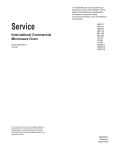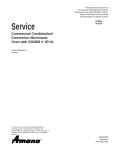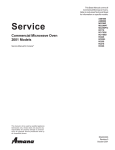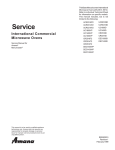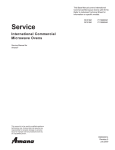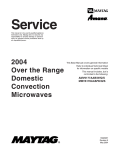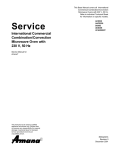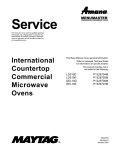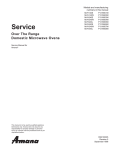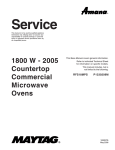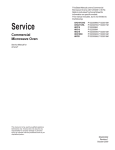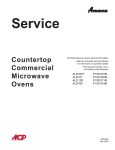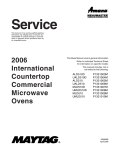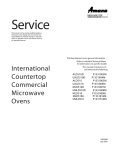Download Amana CRC18T2SD Service manual
Transcript
This Base Manual covers Commercial Microwave Ovens with 120/230 V, 60 Hz. Refer to individual Technical Sheet for information on specific models. This manual includes, but is not limited to the following: Service Compact Commercial Microwave Oven This manual replaces RS2230003 Rev. 1 CRC21T2 CRC18T2 CRC18T2SD CRC12T2 CRC12T CRC10T2 CRC10T FSC18VP FSC12VP FSC10VP Service Manual for Amana® Menumaster® This manual is to be used by qualified appliance technicians only. Amana does not assume any responsibility for property damage or personal injury for improper service procedures done by an unqualified person. RS2230003 Revision 2 December 1998 Important Product Information ! ! WARNING WARNING To avoid risk of electrical shock, injury, or death, make sure these grounding instructions are followed. Precautions to be observed before and during servicing to avoid possible exposure to excessive microwave energy. Grounding Instructions (A) Do not operate or allow oven to be operated with the door open. ! (B) Make the following safety checks on all ovens to be serviced before activating the magnetron or other microwave source, and make repairs as necessary: • Interlock operation • Proper door closing • Seal and sealing surfaces (arcing, wear, and other damage) • Damage to or loosening of hinges and latches • Evidence of dropping or abuse Do not remove grounding prong when installing grounded appliance in a home or business that does not have three wire grounding receptacle, under no condition is grounding prong to be cut off or removed. It is the personal responsibility of the consumer to contact a qualified electrician and have properly grounded three prong wall receptacle installed in accordance with appropriate electrical codes Should a two prong adapter plug be required temporarily it is the personal responsibility of the consumer to have it replaced with properly grounded three prong receptacle or the two prong adapter properly grounded by a qualified electrician in accordance with appropriate electrical codes. (C) Before turning on microwave power for any service test or inspection within the microwave generating compartments, check the magnetron, wave guide or transmission line, and cavity for proper alignment, integrity, and connections. (D) Any defective or misadjusted components in the interlock, monitor, door seal, and microwave generation and transmission systems shall be repaired, replaced, or adjusted by procedures described in this manual before oven is released to the consumer. Servicing of Grounded Products The standard accepted color coding for grounding wires is GREEN or GREEN WITH YELLOW STRIPE. These ground leads are NOT to be used as current carrying conductors. It is extremely important that the technician replace any and all grounds prior to completion of the service call. Under no condition should ground wire be left off causing a potential hazard to technicians and consumer. (E) Check microwave leakage to verify compliance with the Federal Performance Standard should be performed on each oven prior to release to the consumer. WIRING Good service practice is to never route wiring over terminals and/or sharp edges. This applies to any wiring without regard to the circuit voltage. Wire insulation material and thickness is designed and regulated for electrical spacing purpose only, but cannot always be relied upon because of possible cuts and/or abrasions, which can occur during servicing. RS2230003 Rev. 2 WARNING 2 Table of Contents Important Product Information ..................................... 2 Table of Contents ........................................................ 3 Important Information .................................................. 4 Important Safety Information ....................................... 5 Product Information Antenna Blade ......................................................... 8 Blower/Fan Assembly .............................................. 8 Grease Shield .......................................................... 8 Door Interlock and Monitoring Switch ....................... 8 Auto Transformer ..................................................... 8 Transformer High Voltage ......................................... 8 High Voltage Capacitor ............................................ 8 High Voltage Diode (Rectifier) .................................. 8 Magnetron ............................................................... 8 Thermal Protectors .................................................. 8 Touch Panels ........................................................... 8 Triac ........................................................................ 8 Stirrer Motor ............................................................ 8 Installation Unpacking Oven ...................................................... 9 Oven Placement ...................................................... 9 Radio Interference .................................................... 9 Grounding Instructions ............................................. 9 Care and Cleaning Changing Oven Light Bulb ...................................... 10 Cleaning Interior, Exterior, and Door ....................... 10 Cleaning Splatter Shield ........................................ 10 Cleaning Air Intake Filter ....................................... 11 Cleaning Discharge Air Vents ................................ 11 Control Pads ............................................................. 12 Displays .................................................................... 13 Quick Reference Instructions .................................... 14 Operation Power-up Display ................................................... 15 Interrupting Operation ............................................ 15 Canceling Mistakes ............................................... 15 Preprogrammed Times and Cook Level .................. 15 Operating Preprogrammed Pads ............................ 15 Programming Instructions Reviewing Preprogrammed Pads ........................... 16 Manual Time Entry ................................................ 16 Preprogrammed Number Pads ............................... 16 Multiple Heating Stages ......................................... 17 Deactivating Preprogrammed Pad .......................... 17 Reactivating Preprogrammed Pad .......................... 17 Deactivating Control Panel ..................................... 17 Reactivating Control Panel ..................................... 17 User Options ......................................................... 18 Component Testing Procedures ................................ 19 Microwave Power Test ........................................... 22 Radiation Leakage Testing Equipment ............................................................. 23 Procedure for Measuring Radiation Leakage .......... 23 Measurement with Outer Case Removed ............... 23 Measurement with a Fully Assembled Oven .......... 23 Record Keeping and Notification After Measurement ................................................ 23 Troubleshooting Initial Power Up .................................................. 24 Standby Condition .............................................. 25 Cook Condition ................................................... 26 Disassembly Door Removal ........................................................ 27 Inner Door Window Disassembly ........................... 27 Door Disassembly ................................................. 27 Door Handle ........................................................... 27 Hinge ..................................................................... 27 Outer Case ............................................................ 27 Door/Interlock Switch Adjustment/Replacements .. 28 Back Panel ............................................................ 29 Top Antenna Assembly (some models) ................. 29 Bottom Antenna Assembly (some models) ........... 29 Oven Tray Removal ................................................ 29 Stirrer Motor (some models top) ............................ 29 Touch Panel Assembly .......................................... 29 Controller Board ..................................................... 29 Interlock Switch Assembly .................................... 29 Magnetron Cutout (TCO) ........................................ 30 Triac ...................................................................... 30 Diodes ................................................................... 30 Magnetron ............................................................. 30 Cavity Thermal Fuse Replacement ........................ 30 Fuse ...................................................................... 31 Blower Wheel and Motor ........................................ 31 Fan Blade .............................................................. 31 Auto Transformer ................................................... 31 Transformer ........................................................... 31 Capacitor ............................................................... 31 Power Cord ............................................................ 31 Light Socket .......................................................... 32 Replacing Oven Light Bulb ..................................... 32 Component Location Figure 1 .............................................................. 33 Figure 2 .............................................................. 34 Figure 3 .............................................................. 35 Amana Appliances • 2800 220thTrail • Amana, Iowa • 52204-0001 • Printed in the U.S.A. 3 RS2230003 Rev. 2 Important Information Pride and workmanship go into every product to provide our customers with quality products. It is possible, however, that during its lifetime a product may require service. Products should be serviced only by a qualified service technician who is familiar with the safety procedures required in the repair and who is equipped with the proper tools, parts, testing instruments and the appropriate service manual. REVIEW ALL SERVICE INFORMATION IN THE APPROPRIATE SERVICE MANUAL BEFORE BEGINNING REPAIRS. Important Notices for Consumers and Servicers ! WARNING To avoid risk of serious injury or death, repairs should not be attempted by an unauthorized personnel, dangerous conditions (such as exposure to electrical shock) may result. ! CAUTION Amana will not be responsible for any injury or property damage from improper service procedures. If prefroming service on your own product, assume responsibility for any personal injury or property damage which may result. To locate an authorized servicer, please consult your telephone book or the dealer from whom you purchased this product. For further assistance, please contact: CONSUMER AFFAIRS DEPT. AMANA REFRIGERATION, INC. AMANA, IOWA 52204 OR CALL 1-319-622-5511 and ask for Consumer Affairs If outside the United States contact: AMANA ATTN: CONSUMER AFFAIRS DEPT 2800 220th Trail AMANA, IOWA 52204, USA Telephone: (319) 622-5511 Facsimile: (319) 622-2180 TELEX: 4330076 AMANA CABLE: "AMANA", AMANA, IOWA, USA Recognize Safety Symbols, Words, and Labels ! DANGER - DANGER Immediate hazards which WILL result in severe personal injury or death. ! WARNING WARNING - Hazards or unsafe practices which COULD result in severe personal injury or death. ! CAUTION CAUTION - Hazards or unsafe practices which COULD result in minor personal injury or product or property damage. RS2230003 Rev. 2 4 Important Safety Information ! 9. Microwave oven should never be operated with: • Any components removed and/or bypassed • Any of the safety interlocks are found to be defective • Any of the seal surfaces are defective, missing, or damaged CAUTION Do not become exposed to radiation from the microwave generator or other parts conducting microwave energy. 10.To ensure that unit does not emit excessive microwave leakage and to meet Department of Health and Human Services guidelines check oven for microwave leakage using Narda Model 8100, 8200, Holaday HI1500, HI1501, or Simpson 380M leakage monitor as outlined in instructions. Maximum leakage level allowed is 4mw/cm2 . Basic design of this microwave oven makes it an inherently safe device to both use and service. However, there are some precautions which should be followed when servicing microwave oven to maintain this safety. These are as follows: 1. Always operate unit from an adequately grounded outlet. Do not operate on a two-wire extension cord. 11. If servicer encounters an emission reading over 4mw/cm2, servicer is to cease repair and contact Amana Service Department immediately for further direction. Amana will contact the proper government agency upon verification of test results. 2. Before servicing unit (if unit is operable) perform microwave leakage test. 3. Oven should never be operated if door does not fit properly against seal, hinge/hinge bearings are damaged or broken; choke is damaged, (pieces missing, etc.); or any other visible damage can be noted. Check choke area to ensure that this area is clean and free of all foreign matter. If any above problems occur take the following steps: 12.Install or locate this equipment ONLY in accordance with the installation instructions in this manual. 13.Some products such as whole eggs and sealed containers – for example, closed glass jars – may explode and SHOULD NOT be HEATED in this equipment. • Tell the user not to operate the oven. • Contact Amana mmediately. 4. If oven operates with door open and produces microwave energy, take the following steps: 14.Use this equipment ONLY for its intended use as described in this manual. Do not use corrosive chemicals or vapors in this equipment. This type of equipment is specifically designed to heat or cook. It is not designed for industrial or laboratory use. • Tell the user not to operate the oven. • Contact Amana immediately. 5. Always have oven disconnected when outer case is removed except when making "live" tests called for in the service manual. Do not reach into equipment area while unit is energized. Make all connections for the test and check them for tightness before plugging cord into outlet. 15.As with any equipment, CLOSE SUPERVISION is necessary when used by CHILDREN. 16.DO NOT operate this equipment if it has a damaged cord or plug, if it is not working properly, or if it has been damaged or dropped. 6. Always ground capacitors on magnetron filter box and H.V. capacitor with an insulated-handle screwdriver before working in high voltage area of equipment compartment. Some types of failures will leave a charge in capacitors and the discharge could cause a reflex action which could make you injure yourself. 17.This equipment, including power cord, must be serviced ONLY by qualified service personnel. Special tools are required to service equipment. Contact nearest authorized service facility for examination, repair, or adjustment. 7. In the area of the transformer, capacitor, diode, and magnetron there is HIGH VOLTAGE. When unit is operating, keep area clean and free of anything which could possibly cause an arc or ground, etc. 19.DO NOT store this equipment outdoors. DO NOT use this product near water – for example, near a kitchen sink, in a wet basement, or near a swimming pool, and the like. 8. DO NOT for any reason defeat interlock switches, there is no valid reason for this action at any time; nor will it be condoned by Amana. 20.DO NOT immerse cord or plug in water. 18.DO NOT cover or block any openings on the equipment. 21.Keep cord AWAY from HEATED surfaces. 22.DO NOT let cord hang over edge of table or counter. 5 RS2230003 Rev. 2 Important Safety Information ! CAUTION To avoid personal injury or property damage, observe the following: 7. Do not use regular cooking thermometers in oven. Most cooking thermometers contain mercury and may cause an electrical arc, malfunction, or damage to oven. 1. Briskly stir or pour liquids before heating with microwave energy to prevent spontaneous boiling or eruption. Do not overheat. If air is not mixed into a liquid, liquid can erupt in oven or after removal from oven. 8. Do not heat baby bottles in oven. 2. Do not deep fat fry in oven. Fat could overheat and be hazardous to handle. 9. Do not use metal utensils in oven. 10. Never use paper, plastic, or other combustible materials that are not intended for cooking. 3. Do not cook or reheat eggs in shell or with an unbroken yolk using microwave energy. Pressure may build up and erupt. Pierce yolk with fork or knife before cooking. 11. When cooking with paper, plastic, or other combustible materials, follow manufacturer's recommendations on product use. 4. Pierce skin of potatoes, tomatoes, and similar foods before cooking with microwave energy. When skin is pierced, steam escapes evenly. 12. Do not use paper towels which contain nylonor other synthetic fibers. Heated synthetics could melt and cause paper to ignite. 5. Do not operate equipment without load or food in oven cavity. 13. Do not heat sealed containers or plastic bags in oven. Food or liquid could expand quickly and cause container or bag to break. Pierce or open container or bag before heating. 6. Use only popcorn in packages designed and labeled for microwave use. Popping time varies depending on oven wattage. Do not continue to heat after popping has stopped. Popcorn will scorch or burn. Do not leave oven unattended. 14. To avoid pacemaker malfunction, consult physician or pacemaker manufacture about effects of microwave energy on pacemaker. PRECAUTIONS TO AVOID POSSIBLE EXPOSURE TO EXCESSIVE MICROWAVE ENERGY a. DO NOT attempt to operate this oven with the door open since open-door operation can result in harmful exposure to microwave energy. It is important not to defeat or tamper with the safety interlocks. c. DO NOT operater the oven if it is damaged. It particularly important that the oven door close properly and that there is no damage to the: (1) door (bent), (2) hinges and latches (broken or loosened), (3) door seal and sealing surface. b. DO NOT place any object between the oven front face and the door or allow soil or cleaner residue to accumulate on sealing surfaces. d. The oven should NOT be adjusted or repaired by anyone except properly qualified service personnel. RS2230003 Rev. 1 6 Important Safety Information Recognize this symbol as a SAFETY message ! WARNING When using electrical equipment, basic safety precautions should be followed to reduce the risk of burns, electrical shock, fire, or injury to persons. 1. READ all instructions before using equipment. 8. DO NOT operate this equipment if it has a damaged cord or plug, if it is not working properly, or if it has been damaged or dropped. 2. READ AND FOLLOW the specific “PRECAUTIONS TO AVOID POSSIBLE EXPOSURE TO EXCESSIVE MICROWAVE ENERGY”. 9. This equipment, including power cord, must be serviced ONLY by qualified service personnel. Special tools are required to service equipment. Contact nearest authorized service facility for examination, repair, or adjustment. 3. This equipment MUST BE GROUNDED. Connect only to properly GROUNDED outlet. See “GROUNDING INSTRUCTIONS”. 10. DO NOT cover or block filter or other openings on equipment. 4. Install or locate this equipment ONLY in accordance with the installation instructions in this manual. 11. DO NOT store this equipment outdoors. DO NOT use this product near water – for example, near a kitchen sink, in a wet basement, or near a swimming pool, and the like. 5. Some products such as whole eggs and sealed containers – for example, closed glass jars – may explode and SHOULD NOT be HEATED in this oven. 12. DO NOT immerse cord or plug in water. 6. Use this equipment ONLY for its intended use as described in this manual. Do not use corrosive chemicals or vapors in this equipment. This type of oven is specifically designed to heat or cook. It is not designed for industrial or laboratory use. 14. DO NOT let cord hang over edge of table or counter. 7. As with any equipment, CLOSE SUPERVISION is necessary when used by CHILDREN. 16. For commercial use only. ! 13. Keep cord AWAY from HEATED surfaces. 15. See door cleaning instructions in “Care and Cleaning” section. CAUTION To reduce the risk of fire in the oven cavity: a. DO NOT overcook food. Carefully attend equipment if paper, plastic, or other combustible materials are placed inside the oven to facilitate cooking. c. KEEP oven DOOR CLOSED, turn oven off, and disconnect the power cord, or shut off power at the fuse or circuit breaker panel, if materials inside the oven should ignite. Fire may spread if door is opened. b. Remove wire twist-ties from paper or plastic bags before placing bag in oven. d. DO NOT use the cavity for storage. DO NOT leave paper products, cooking utensils, or food in the cavity when not in use. 7 RS2230003 Rev. 1 Product Information Antenna Blade Auto Transformer Distributes microwave energy throughout the cavity. Auto transformer in this unit provides a voltage of 120, 208, or 230 VAC. Blower/Fan Assembly Transformer High Voltage Circulates cooling air throughout the microwave oven compartment and cavity. High voltage transformer is used in this unit, which supplies high voltage A.C. for operation of the magnetron tube. Grease Shield Covers and protects the antenna blade assembly. High Voltage Capacitor Doubles the A.C. output voltage from the high voltage transformer. Door Interlock and Monitoring Switch NOTE: When the line fuse is blown the Interlock Switch Assembly must be replaced. High Voltage Diode (Rectifier) Interlock switch assembly mounts behind oven cavity front bulkhead. Switches are actuated by the door hooks. Is connected at the output side of the high voltage capacitor. It changes voltage from A.C. to D.C. It passes current in one direction and blocks it in the other. Also called a rectifier. Monitoring switch (contacts COM and NC) is actuated by the top door hook. The primary interlock switch (contacts COM and NO) is actuated by the top door hook. Magnetron With filament voltage and high D.C. voltage from the output of the H.V. capacitor, diode junction, the magnetron will put out an electomagnetic radio frequency of 2450 MHz to heat the food load in the oven. The logic switch (contacts COM and NO) is actuated by the bottom door hook. The secondary interlock switch (contacts COM and NO) is actuated by the bottom door hook. If a malfunction occurs in the primary interlock when door opens, current will flow through the monitor switch causing the oven fuse to open. Thermal Cutout Protectors If a faulty door interlock switch has allowed current through the monitor switch, the switch assembly must be replaced (see interlock switch testing) before replacing fuse. • Magnetron thermal cut-outs are mounted directly on the body of the magnetron. • Cavity thermal cut-out is mounted directly on the left side of cavity exterior. ! At a predetermined temperature, the thermal cut-outs will open. DANGER Touch Panels To avoid severe personal injury or death avoid contacting any high voltage parts. The capacitors are at high voltage (4000 volt) potential and it is extremely important that they be grounded before handling. Allows consumer operation and programming of oven. Triac Triac is controlled by control board. Triac controls one side of the power line going to the high voltage power transformer. • Triac is mounted inside oven chassis behind oven cavity front bulkhead, towards rear of unit in front of blower motor, underneath insulator. Stirrer Motor Stirrer motor rotates top antenna assembly. RS2230003 Rev. 1 8 Installation Unpacking Oven Grounding Instructions • Remove packing and printed material from oven cavity. • Inspect oven for damage such as dents in door or inside oven cavity. • Report any dents or breakage to source of purchase immediately. Do not attempt to use oven if damaged. • If oven has been stored in extermely cold area, wait a few hours before connecting power. NOTE: Do not under any circumstances cut or remove grounding prong from the plug or bend power prongs to fit receptacle other than one shown for your equipment. Such abuse of the plug can result in electrical shock or overheating. ! WARNING Improper use of grounding plug can result in a risk of electrical shock or death. Oven Placement This equipment MUST be grounded. In the event of an electrical short circuit, grounding reduces risk of electric shock by providing an escape wire for electric current. This oven is equipped with a cord having grounding wire with a grounding plug. Plug must be plugged into an outlet that is properly installed and grounded. DO NOT use a two-prong adapter. • Do not install oven next to or above source of heat, such as pizza oven or deep fat fryer. Excessive heat may cause oven to operate improperly and shorten life of electrical parts. • Restricted air flow may cause oven to operate improperly and shorten life of electrical parts. • Install according to all local building codes and ordinances. Consult a qualified electrician or servicer if grounding instructions are not completely understood, or if doubt exists as to whether the equipment is properly grounded. Radio Interference Do not use an extension cord. If product power cord is too short, have a qualified electrician install an appropriate receptacle. This equipment should be plugged into a separate 60 Hz circuit with the appropriate electrical rating as shown in the drawings. When an oven is on a circuit with other equipment, an increase in cooking times may be required and fuses can be blown. Microwave operation may cause interference to radio, television, or similar equipment. Reduce or eliminate interference by doing the following: • Clean door and sealing surfaces of oven according to instructions in "Care and Cleaning" section. • Place radio, television, etc. as far as possible from oven. • Use properly installed antenna on radio, television, etc. to obtain stronger signal reception. NEMA 5-20R/5-20P NEMA 6-20R/6-20P 120V–20AMP 230V/208V–20AMP 9 RS2230003 Rev. 1 Care and Cleaning Changing Oven Light Bulb ! CAUTION To avoid electrical shock hazard unplug power cord or open circuit breaker to microwave oven before replacing light bulb. After replacing light bulb, reconnect power. ! CAUTION To avoid burns and cuts, wear gloves to protect hands should bulb break. If hot, allow bulb to cool. Tools and Bulb • Protective gloves • Standard screwdriver or ¼ inch socket • Light bulb rated 120 volt, 25 watt 4. Remove bulb by turning counterclockwise, being careful not to burn fingers or break bulb. • Replace with bulb rated 120 volt, 25 watt. 5. Slide rail into oven cavity, replace access cover and screws. When installing screws attach rail to access cover first, for easier installation. 1. Unplug oven. 2. Remove screws from back of oven and remove access cover. 6. Plug in oven. • See figure below. Cleaning Interior, Exterior, and Door ! WARNING To avoid electrical shock which can cause severe personal injury or death, unplug power cord or open circuit breaker to oven before cleaning. Clean microwave oven with mild detergent in warm water using soft sponge or cloth. Wring sponge or cloth to remove excess water before wiping equipment. If desired, boil a cup of water in microwave oven to loosen soil before cleaning. • Do not use abrasive cleansers or cleaners containing ammonia. These could damage finish. • Never pour water into microwave oven bottom. • Do not use water pressure type cleaning systems. Cleaning Splatter Shield Splatter shield keeps top of microwave oven cavity and antenna from becoming soiled. Clean soil from shield with damp cloth or clean with mild detergent and water. Remove splatter shield for easy cleaning. 1. Unplug oven before removing splatter shield to stop antenna from rotating. 3. Slide rail out oven from oven cavity. 2. Place fingers behind shield, pull forward, and down. • See figure below. RS2230003 Rev. 1 • When removing and replacing splatter shield, be careful not to bend antenna. 10 Care and Cleaning 3. Wash shield in hot, soapy water. Rinse and dry thoroughly. ! CAUTION To avoid oven door damage, do not lift oven by oven door. • Do not wash splatter shield in dishwasher. • Do not use abrasive cleaners. 4. Reinstall splatter shield by placing front portion of the shield in first. Lift until shield slides into holes located in back of oven. Filter is located below oven door. Clean air intake filter weekly for proper air flow. Wash filter in hot water and mild detergent. Do not use oven without filter in place. Remove filter to clean. Correct Installation Method 1 1. Open oven door and lift front of oven by pushing up on front of oven cavity ceiling. 2. Slide filter down and out of oven frame. • Pull down on corners of filter. 3. Reverse procedure to reinstall. Method 2 1. Slide filter to left or right until side of filter frame clears oven frame. Incorrect Installation (Shield in upside down) 2. Pull side of filter frame out of oven frame and slide right or left until clear of oven. 3. Reverse procedure to reinstall. Cleaning Discharge Air Vents Check for a buildup of cooking vapors along discharge louvers in back of oven. Clean air vent with damp cloth to ensure proper airflow. Dry thoroughly. NOTE: If splatter shield is installed upside down, shield will interfere with antenna movement. Cleaning Air Intake Filter ! CAUTION To avoid overheating and oven damage, clean air filter regularly. Discharge air vent 11 RS2230003 Rev. 1 Control Pads Amana Units Menumaster Units TIME ENTRY POWER LEVEL • Use to enter heating time without changing preprogrammed number pads. • Used to view preprogrammed pads. • Deactivating control panel. • Use to select power level. Oven can heat at full or reduced power. If oven power level is set to 0% oven does not heat for programmed time. Adjust power in increments of 10%. If no power level is selected, oven operates at 100% power. • Used to program or change user options. MENU b/d • Use to switch between 2 independent preprogrammed menus, containing 10 preprogrammed pads for a total of 20 preprogrammed pads. Pads are programmed to heat for specific time and power level. • Used to program multiple heating stages. • Deactivating preprogrammed pads. • Reactivating preprogrammed pads. START • Use to start “Manual Time Entry” program or restart interrupted cooking cycle. Use to advance to next user option, (see page 18). Use to save times and power levels when programming pads. STOP/RESET Pads 1-0 • Use to exit programming mode and stop cooking during cooking cycle. • Use to begin heating with preprogrammed times and power levels or to enter times for “Manual Time Entry” cooking. RS2230003 Rev. 1 12 Displays • Shows after oven is plugged in. Open oven door to clear. READY • “Pb” or “Pd”—Indicates programming mode and current menu. See “Programming” section of manual for programming procedure. READY • “b” or “d”—Shows active menu. • “READY”—Indicates pads will accept entry. Shows when oven is paused or ready for next entry. • "bP1"—Indicates menu "b" in programming mode, and stage 1. The smaller "1" indicates pad 1 is being programmed. POWER COOK LEVEL • “88:88”—Shows heating time. • “POWER”—Shows when oven generates microwave energy. • “COOK LEVEL”—Shows when viewing stage with reduced power or hold. Power level digit or blank space shows above “COOK LEVEL” in display. Blank space indicates full power. • “OP:11”—Indicates programming user options mode. See “User Options” section of manual for programming procedure. • “LOC”—Indicates control panel is locked and will not accept entries. See “Deactivating Control Panel” section of manual for activating and deactivating procedure. 13 RS2230003 Rev. 1 Quick Reference Instructions Read “Important Safety Information” before using “Quick Reference Instructions”. If there are unanswered questions, see detailed sections of this manual. Instructions are written for factory programmed ovens. Ovens that are reprogrammed can respond differently than described below. Operating Preprogrammed Pads 1. Open oven door, place food in oven, and close oven door. 2. Press MENU b/d pad to select preprogrammed menu. 3. Press desired number pad. 4. Oven stops heating and oven signal sounds when heating time elapses. Reviewing Preprogrammed Pads 1. Open oven door. 2. Press and hold TIME ENTRY pad for approximately 5 seconds. 3. Press MENU b/d pad to select preprogrammed menu if necessary. 4. Press desired number pad. 5. Press TIME ENTRY pad to review heating stages for pad. 6. Press START pad after reviewing preprogrammed pad. 7. Press RESET pad or close oven door to exit programming mode. Manual Time Entry 1. Open oven door, place food in oven, and close oven door. 2. Press TIME ENTRY pad. 3. Press number pads to enter desired cooking time. 4. Press POWER LEVEL pad if power level other than 100 percent is required. 5. Press number pad to enter desired power level. 6. Press START pad. 7. Oven stops heating and oven signal sounds when heating timing elapses. Programming Number Pads 1. Open oven door. 2. Press and hold pad 1 for approximately 5 seconds. 3. Press MENU b/d pad to select preprogrammed menu if necessary. 4. Press desired number pad. 5. Press number pads to enter desired cooking time. 6. Press POWER LEVEL pad if power level other than 100 percent is required. 7. Press number pad to enter desired power level. 8. Press START pad to save new heating time and power level in oven memory. 9. Press RESET pad or close oven door to exit programming mode. RS2230003 Rev. 1 Programming Multiple Heating Stages 1. Open oven door. 2. Press pad 1 for approximately 5 seconds. 3. Press MENU b/d pad to select preprogrammed menu if necessary. 4. Press desired number pad. 5. Press number pads to enter desired cooking time. 6. Press POWER LEVEL pad if power level other than 100 percent is required. 7. Press number pad to enter desired power level. 8. Press TIME ENTRY pad. 9. Press START pad to save new heating time and power level in oven memory. 10. Press RESET pad or close oven door to exit programming mode. 11. Repeat for 3rd and 4th stages. Deactivating Preprogrammed Pad 1. Open oven door. 2. Press and hold pad 1 for approximately 5 seconds. 3. Press desired number pad. 4. Press MENU b/d pad. 5. Press START pad to save in oven memory. 6. Press RESET pad or close oven door to exit programming mode. Reactivating Preprogrammed Pad 1. Open oven door. 2. Press and hold pad 1 for approximately 5 seconds. 3. Press desired number pad. 4. Press MENU b/d pad. 5. Program pad according to “Preprogrammed Number Pads” section step 5-8. 6. Press START pad to save in oven memory. 7. Press RESET pad or close oven door to exit programming mode. Deactivating Control Panel 1. Open oven door, and close oven door. 2. Press TIME ENTRY pad. 3. Press 1,3,5, and 7 pad in sequence. 4. Press TIME ENTRY pad. Reactivating Control Panel • Reactivate control panel by repeating steps 1-4 of "Deactivating Control Panel". User Options 1. Open oven door. Display shows “MENU b OR d – READY”. 2. Press and hold pad 1 for approximately 5 seconds. 3. Press POWER LEVEL pad. 4. Press START pad to advance to next option. See table for options. 5. Press number pad (0,1-3) to change option. 6. Press START pad to save changes. 7. Press RESET pad or close oven door to exit programming mode. 14 Operation Power-up Display Operating Preprogrammed Pads After equipment is plugged in, display shows 4 large dashes and 1 small dash. Open and close oven door to clear display and activate pads. Equipment has 2 menus with 10 preprogrammed number pads. 1. Open oven door, place food in oven, and close oven door. • Display shows “b” or “d” and “READY”. • Fan and light operate. • If pad is not pressed in 30 seconds, open and close oven door again. Interrupting Operation • Open oven door to interrupt operation. Oven fan continues to operate. Close door and press START pad to resume oven operation. • Press STOP/RESET pad to interrupt operation. Display continues to show countdown time. Press START pad to resume oven operation and countdown timing. 2. Press MENU b/d pad to select preprogrammed menu. • “b” or “d” shows in display. 3. Press desired number pad. • Oven operates and time counts down. • Display shows heating time, “POWER”, ”COOK LEVEL”. • Display shows “POWER” only when microwave energy is present. • If power level other than 100 percent power was programmed, display shows “COOK LEVEL” and power level. Display counts down cooking time. Canceling Mistakes • If oven is not operating, press STOP/RESET pad to clear display. • If oven is operating, press STOP/RESET pad once to stop oven, then again to clear display. • If oven door is open and time shows in display, close oven door and press STOP/RESET pad to clear display. • If additional heating time is required, press preprogrammed pads before or after heating cycle ends. 4. Oven stops heating and oven signal sounds when heating timing elapses. Preprogrammed Times and Cook Level All preprogrammed pads arrive set at full power. Menus “b” and “d” are programmed identically at factory. Pads Heating Times 1 10 seconds 2 20 seconds 3 30 seconds 4 45 seconds 5 1 minute 6 1 minute 30 seconds 7 2 minutes 8 3 minutes 9 4 minutes 0 5 minutes 15 RS2230003 Rev. 1 Programming Instructions Reviewing Preprogrammed Pads 1. Open oven door. • Display shows “b” or “d” and “READY”. 6. Press START pad. • Oven operates and time counts down. • Display shows heating time, “POWER”, “COOK LEVEL”. • Fan and light operate. • Display shows “POWER” only when microwave energy is present. • If door is closed or RESET pad is pressed before finishing programming sequence, oven exits programming mode. 2. Press and hold TIME ENTRY pad for approximately 5 seconds. • After 5 seconds, signal sounds. Display shows “Pb” or “Pd” indicating “b” or “d” menu. 3. Press MENU b/d pad to select preprogrammed menu if necessary. 4. Press desired number pad. • Display shows heating time, “COOK LEVEL” and power level if other than 100 percent power. 5. Press TIME ENTRY pad to review heating stages for pad. • “(bP or dP)” and stage show briefly, then heating time, “COOK LEVEL” and power level if other than 100 percent power show in display. 6. Press START pad after reviewing preprogrammed pad. • Display shows “Pb” or “Pd” indicating “b” or “d” menu. • Repeat steps 3-6 to review another preprogrammed pad. 7. Press RESET pad or close oven door to exit programming mode. Manual Time Entry 1. Open oven door, place food in oven, and close oven door. • Display shows “b” or “d” and “READY”. • If power level other than 100 percent power was programmed, display shows “COOK LEVEL” and power level. Display counts down cooking time. 7. Oven stops heating and oven signal sounds when heating timing elapses. Preprogrammed Number Pads 1. Open oven door. • Display shows “b” or “d” and “READY”. • Fan and light operate. • If door is closed or RESET pad is pressed before finishing programming sequence, oven exits programming mode. 2. Press and hold pad 1 for approximately 5 seconds. • After 5 seconds, signal sounds. Display shows “Pb” or “Pd” indicating “b” or “d” menu. 3. Press MENU b/d pad to select preprogrammed menu if necessary. 4. Press desired number pad. • Display shows heating time, “COOK LEVEL” and power level if other than 100 percent power. 5. Press number pads to enter desired cooking time. • For example, to heat for 2 minutes 30 seconds, press 2, 3, and 0 pads. • Fan and light operate. 6. Press POWER LEVEL pad if power level other than 100 percent is required. • Display shows “COOK LEVEL” and current power level if other than 100 percent power. • If pad is not pressed in 30 seconds, open and close oven door again. 7. Press number pad to enter desired power level. • For example, pressing 2 pad is 20 percent power. 2. Press TIME ENTRY pad. • Display shows “0000” and “READY”. 3. Press number pads to enter desired cooking time. • For example, to heat for 2 minutes 30 seconds, press 2, 3, and 0 pads. 4. Press POWER LEVEL pad if power level other than 100 percent is required. • Display shows “COOK LEVEL” and current power level if other than 100 percent power. 8. Press START pad to save new heating time and power level in oven memory. • Display shows “Pb” or “Pd” indicating “b” or “d” menu. • Repeat step 3-8 to program additional pads. 9. Press RESET pad or close oven door to exit programming mode. 5. Press number pad to enter desired power level. • For example, pressing 2 pad is 20 percent power. RS2230003 Rev. 1 16 Programming Instructions Multiple Heating Stages Oven can be programmed to perform 4 independent heating cycles without interruption. 1. Open oven door. • Display shows “b” or “d” and “READY”. • Fan and light operate. • If door is closed or RESET pad is pressed before finishing programming sequence, oven exits programming mode. 2. Press pad 1 for approximately 5 seconds. • After 5 seconds, signal sounds. Display shows “Pb” or “Pd” indicating “b” or “d” menu. 4. Press MENU b/d pad. • “dddd” and pad number show in display. 5. Press START pad to save in oven memory. • To reactivate pad, repeat steps. 6. Press RESET pad or close oven door to exit programming mode. Reactivating Preprogrammed Pad 1. Open oven door. • Display shows “b” or “d” and “READY”. • Fan and light operate. • If door is closed or RESET pad is pressed before finishing programming sequence, oven exits programming mode. 3. Press MENU b/d pad to select preprogrammed menu if necessary. 4. Press desired number pad. • Display shows heating time, “COOK LEVEL” and power level if other than 100 percent power. 2. Press and hold pad 1 for approximately 5 seconds. • After 5 seconds, signal sounds. Display shows “Pb” or “Pd” indicating “b” or “d” menu. 5. Press number pads to enter desired cooking time. • For example, to heat for 2 minutes 30 seconds, press 2, 3, and 0 pads. 3. Press desired number pad. • Display shows heating time, “COOK LEVEL” and power level if other than 100 percent power. 6. Press POWER LEVEL pad if power level other than 100 percent is required. • Display shows “COOK LEVEL” and current power level if other than 100 percent power. 4. Press MENU b/d pad. • Display shows “0000” and “READY”. 7. Press number pad to enter desired power level. • For example, pressing 2 pad is 20 percent power. 8. Press TIME ENTRY pad. • Display briefly shows "bP1(1-9,0)" or "dP1(1-9,0)" indicating menu, programming, stage, and pad. Then cook time and power level for stage show in display. • Repeat steps 5-8 to create additional stages. 5. Program pad according to “Preprogrammed Number Pads” section step 5-8. 6. Press START pad to save in oven memory. • To reactivate pad, repeat steps. 7. Press RESET pad or close oven door to exit programming mode. Deactivating Control Panel 1. Open oven door, and close oven door. • Display shows “b” or “d” and “READY”. 9. Press START pad to save new heating time and power level in oven memory. 10. Press RESET pad or close oven door to exit programming mode. Deactivating Preprogrammed Pad 1. Open oven door. • Display shows “b” or “d” and “READY”. • Fan and light operate. • Fan and light operate. • If pad is not pressed in 30 seconds, open and close oven door again. 2. Press TIME ENTRY pad. • Display shows “0000” and “READY”. 3. Press 1,3,5, and 7 pad in sequence. 4. Press TIME ENTRY pad. • “LOC” shows in display. • All pads except TIME ENTRY are disabled. • If door is closed or RESET pad is pressed before finishing programming sequence, oven exits programming mode. 2. Press and hold pad 1 for approximately 5 seconds. • After 5 seconds, signal sounds. Display shows “Pb” or “Pd” indicating “b” or “d” menu. • To reactivate control repeat steps 1-4. Reactivating Control Panel • Reactivate control panel by repeating steps 1-4 of "Deactivating Control Panel". 3. Press desired number pad. • Display shows heating time, “COOK LEVEL” and power level if other than 100 percent power. 17 RS2230003 Rev. 1 Programming Instructions User Options 1. Open oven door. Display shows “MENU b OR d – READY”. • If door is closed or RESET pad is pressed before finishing programming sequence, oven exits programming mode. 2. Press and hold pad 1 for approximately 5 seconds. • After 5 seconds, signal sounds. Display shows “Pb” or “Pd” indicating “b” or “d” menu. 4. Press START pad to advance to next option. See table for options. 5. Press number pad (0,1-3) to change option. 6. Press START pad to save changes. • Repeat steps 4-6 to change additional options. 7. Press RESET pad or close oven door to exit programming mode. 3. Press POWER LEVEL pad. • Displays shows “OP:1(0,1-3)”. • “OP” represents optional program mode, first number represents option number and second number represents functions currently selected for option. Numbered Pads Display Options ( ) = Factory Setting 1 OP:10 OP:11 Prevents adding heating time while oven is heating. (Allows adding heating time while oven is heating.) 2 OP:20 OP:21 Sounds 3 second signal at end of heating cycle. (Sounds 4 short signals at end of heating cycle.) 3 OP:30 OP:31 (Allows 99 minutes 99 seconds of heating time.) Allows 10 minutes of heating time. 4 OP:40 OP:41 Prevents signal when pad is pressed. (Allows signal when pad is pressed.) 5 OP:50 OP:51 (Allows oven to resume heating time countdown after door is opened during cycle.) Cancels heating time count down after door is opened during cycle. 6 OP:60 OP:61 (Allows use of power levels.) Prevents use of power levels. 7 OP:70 OP:71 OP:72 OP:73 Eliminates end of heating cycle signal. Sets end of heating cycle signal volume to low. Sets end of heating cycle signal volume to medium. (Sets end of heating cycle signal volume to high.) 8 OP:80 OP:81 OP:90 OP:91 Sets oven to standard operation. Blower starts when oven starts. (Sets oven to instant−on operation. Blower starts when oven door is opened.) (Allows use of variable time entry and preprogrammed pads.) Allows use of preprogrammed pads only. OP:00 OP:01 (Allows lockout to be programmed.) Prevents lockout from being programmed. 9 0 RS2230003 Rev. 1 18 Component Testing Procedures ! WARNING To avoid risk of electrical shock, personal injury, or death, disconnect power to oven and discharge capacitor before servicing, unless testing requires it. Illustration Component Thermal Cutout Diode Assembly Testing Disconnect all wires from TCO. Measure resistance across terminals. Cavity Thermal Fuse Magnetron TCO Discharge Capacitors Remove diode lead from capacitor and connect ohmmeter. Reverse leads for second test. Triac Disconnect wires to triac. Capacitor Measure resistance from: MT1 to MT2 MT1 to Gate MT2 to Gate All terminals to ground Discharge Capacitors MT2 MT1 GA TE Magnetron Measure resistance across terminals. Discharge Capacitors Infinite Between Terminals: Less than 1 Ω Remove wires from magnetron and connect ohmmeter to terminals. Also check between each terminal and ground. Each terminal to ground measures Infinite resistance. Note: This test is not conclusive. If oven does not heat and all other components test good replace the magnetron and retest. 230 208 120 RS2230003 Rev. 2 Infinite Approximately 40 Ω or more Infinite Infinite Snubber Assembly Auto Transformer CRC21T2, CRC18T2, CRC18T2SD FSC18VP Caution - Do not operate oven with wire to terminal MT2 removed. Terminal to Case: Infinite resistance Wire Harness 230 NOTE: Analog meter must contain a battery of 6 volts minimum. Also check between each terminal and capacitor case. Disconnect wires to snubber. Stirrer motor 120 Infinite resistance should be measured in one direction and 50KΩ or more in the opposite direction. Between Terminals: Meter should momentarily deflect towards zero then return to over 5 MΩ. IF no deflection occurs, or if continuous deflection occurs, replace capacitor. Remove all wires from motor. Measure resistance across coil. 208 Open at 219°F (104°C) Open at 280°F and closed at 180°F Remove wires from capacitor terminals and connect ohmmeter, set on highest resistance scale to terminals. Blower Motor COM Results 0 Approximately 30 Ω Remove all wires from motor. Measure resistance across terminals. Test continuity of wires. Discharge Capacitors Remove all wires from terminals. Measure resistance from: 230 to 0 208 to 0 120 to 0 19 Approximately 3400 Ω Indicates continuity 42.4 Ω 38.6 Ω 21.5 Ω Component Testing Procedures ! WARNING To avoid risk of electrical shock, personal injury, or death, disconnect power to oven and discharge capacitor before servicing, unless testing requires it. Illustration Component Transformer 5 6 8 4 1 3 7 2 Terminal 1− Common Terminal 2− 230 V Terminal 3−208 V #4 #1 -300 MA 1.0 F #3 -300 MA 1.0 F #2 #5 #6 #7 #8 6 7 8 1 #4 #1 4 1.0 F -300 MA 1.0 F -300 MA #2 #5 5 2 Terminal 1− Common Terminal 2−120 V 6 #6 #7 CRC12T2, CRC12T, FSC12VP Transformer 5 4 6 1 2 1 Primary Logic Secondary * NOTE: 1 Gray CRC10T2, CRC10T, FSC10VP Interlock switch assembly * Results 1.0 Ω Less than 1 Ω Less than 1 Ω Less than 1 Ω 30 Ω Infinite resistance should be indicated, if not replace transformer. 2 Red Discharge Capacitor Remove all wires from terminals, and measure resistance from: Terminal 1 to 2 Terminal 5 to 6 Terminal 7 to 8 Terminal 4 to Ground screw on transformer Terminal 4 to any other terminal Less than 1 Ω Less than 1 Ω Less than 1 Ω 40 Ω Infinite resistance should be indicated, if not replace transformer. 2 Red Discharge Capacitor Remove all wires from terminals, and measure resistance from: Terminal 1 to 2 Terminal 5 to 6 Terminal 4 to Ground screw on transformer Terminal 4 to any other terminal 4 Terminal 1− 120 V Terminal 2− Common Monitor 1 Gray #8 5 2 Violet 3 CRC21T2, CRC18T2, CRC18T2SD FSC18VP Transformer Ground Testing Discharge Capacitors Remove all wires from terminals. Measure resistance from: Terminal 1 to 2 Terminal 1 to 3 Terminal 5 to 6 Terminal 7 to 8 Terminal 4 to Ground screw on transformer Terminal 4 to any other terminal 2 1 Gray Red Less than 1 Ω Less than 1 Ω 78 Ω Infinite resistance should be indicated, if not replace transformer. Disconnect wires to switch. With door open measure resistance from: Terminal C to NC Monitor Terminal C to NO Primary Terminal C to NO Logic Terminal C to NO Secondary With door closed measure resistance from: Terminal C to NC Monitor Terminal C to NO Primary Terminal C to NO Logic Terminal C to NO Secondary Door Closed C NC Monitor C C C NO NO NO Primary Logic Secondary Indicates continuity Infinite Infinite Infinite Infinite Indicates continuity Indicates continuity Indicates continuity The two lower switches on the switch assembly (logic and secondary) may be reversed. Both switch configurations are acceptable. 20 RS2230003 Rev. 2 Component Testing Procedures ! WARNING To avoid risk of electrical shock, personal injury, or death, disconnect power to oven and discharge capacitor before servicing, unless testing requires it. 1 10 10 G F H A C B K E D J2 Testing A—Not used B—Normally open terminal on primary switch C—Output to high voltage transformer D—Output to oven light, antenna and blower motors E—Not used F—Triac MT1 terminal G—Triac MT2 terminal H—Triac gate terminal K—Oven TCO protector Results B to C—Line voltage * (Standby Condition) B to C—0 volts * (Cook Condition) D to K— Line voltage * (Idle Condition) D to K—0 volts * (Standby and Cook Conditions) F to H—.75 volts AC approximately * (Cook Condition) J1 connector Pin 3—K J1 connector Line voltage * (All Condition) 1 J1 Pin #1 Component Controller board J1 Illustration J2 Pin #1 Pin 3—D 240 VAC 208 VAC Line Voltage 0 VAC * (Cook Conditons) Line Voltage * (All Conditons) Pin 1—Pin 3 With J1 connector disconnected Pin 6—Pin 7 Pin6—PIN 7 Touch Panel Assembly J2 connector used for touch panel ribbon Continuity is indicated as 100 Ω and below. 10 9 8 7 6 5 Split 4 3 2 1 Continuity test Door closed—continuity Door open—open circuit Pad 1 2 3 4 5 6 7 8 9 Time Entry Power Level Menu b/d Start Stop/Reset Trace 7&4 7&6 6&5 5&4 5&3 6&3 9&6 7&3 8&7 9&4 9&7 9&8 10 & 4 10 & 9 Measurement Continuity Continuity Continuity Continuity Continuity Continuity Continuity Continuity Continuity Continuity Continuity Continuity Continuity Continuity Conditions Idle Condition: Oven plugged in, display blank (no other components operating). Initial Power Up Condition: Apply power to oven with door closed—see, “Troubleshooting” section. Standby Condition: Open oven door, light and motors operate—see, “Troubleshooting” section. Cook Condition: Food load in oven, cook cycle initiated—see, “Troubleshooting” section. RS2230003 Rev. 2 21 Test Modes Microwave Power Test NOTE: Use a watch second hand, not the oven timer. (TRADITIONAL TEST METHOD) Test Equipment Needed: 4. Stir the water, measure and record the temperature of the water after heating time is completed. • Amana power test kit R0157397 (Fahrenheit) or • Menumaster power test kit M95D5 (Centigrade) 1. Fill the plastic container to the bottom of the 1000 ml. lines with cool tap water. 5. Subtract the starting water temperature (Step 2) from the ending water temperature (Step 4) to obtain the temperature rise. 2. Using the thermometer; Fahrenheit or Centigrade, stir the water, measure and record the water temperature. IMPORTANT: Initial water temperature should be approximately 60°F (20°C). NOTE: Variation or errors in the test procedure will cause a variance in the temperature rise indication. Additional power tests should be made if temperature rise appears marginal. 3. Place the container on the center of the oven shelf and heat the water for 63 seconds for ovens rated less then 1550 watts or 33 seconds for ovens with more then 1550 watts of power. NOTE: Low line voltage may cause lower power output (temperature rise). 6. Refer to the Temperature Chart. NOTE: Always perform 3 tests for accuracy. Change water after each test Temperature Chart ONE MINUTE, THREE SECONDS run time chart for units less than 1550 watts cooking power. ∆T (°F) Cooking Power Output ∆T Cooking ∆T (°F) Power Output (°C) Cooking Power Output ∆T Cooking (°C) Power Output 12 464 27 1046 7 490 15 1050 13 504 28 1085 8 560 16 1120 14 542 29 1124 9 630 17 1190 700 18 1260 15 581 30 1162 10 16 620 31 1201 11 770 19 1330 17 659 32 1240 12 840 20 1400 18 697 33 1279 13 910 21 1470 19 736 34 1317 14 980 22 1540 20 775 35 1359 21 814 36 1395 22 852 37 1434 23 891 38 1472 24 930 39 1511 25 969 40 1550 26 1007 THIRTY THREE SECONDS run time chart for units more than 1550 watts cooking power. ∆T (°F) Cooking Power Output ∆T Cooking ∆T (°F) Power Output (°C) Cooking Power Output ∆T Cooking (°C) Power Output 20 1550 28 2170 11 1540 15.5 2170 21 1627 29 2247 11.5 1610 16 2240 22 1705 30 2325 12 1680 16.5 2310 23 1782 31 2402 12.5 1750 17 2380 24 1860 32 2480 13 1820 17.5 2450 25 1937 33 2557 13.5 1890 18 2520 1960 18.5 2590 26 2015 34 2635 14 27 2092 35 2712 14.5 2030 19 2660 15 2100 19.5 2730 RS2230003 Rev. 1 22 Microwave Energy Leakage Testing ! Measurement With the Outer Case Removed WARNING ! Check for radiation leakage after servicing. Should the leakage be more than 4mW/cm2 inform Amana immediately. After repairing or replacing any radiation safety device, keep a written record for future reference, as required by D.H.H.S. and HEW regulations. This requirement must be strictly observed. In addition, the leakage reading must be recorded on the service repair ticket while at the customer’s location. DANGER To avoid risk of personal injury or death avoid contacting any high voltage components. Whenever you replace the magnetron, measure for radiation leakage before the outer case is installed and after all necessary components are replaced or adjusted. Special care should be taken in measuring around the magnetron. Equipment Measurement With a Fully Assembled Oven • Electromagnetic radiation monitor • 600 cc glass beaker After all components, including the outer panel are fully assembled, measure for radiation leakage around the door periphery, the door viewing window, the exhaust opening, and air inlet openings. Procedure For Measuring Radiation Leakage Note before measuring - Record Keeping and Notification After Measurement • Do not exceed meter full scale deflection. Leak monitor should initially be set to the highest scale. • To prevent false readings the test probe should be held by the grip portion of the handle only. • The scan speed is equal to one inch per antenna revolution or one inch per second if antenna speed is unknown. • Areas to be checked are all door seal areas and any venting parts. • Leakage with the outer panel removed, 4mW/cm2 or less. • Leakage for fully assembled oven with door normally closed, 4mW/cm2 or less. • Leakage for a fully assembly oven (before the latch switch (primary) is interrupted) while pulling the door, 4mW/cm2 or less. 1. After any adjustment or repair to a microwave oven, a leakage reading must be taken. Record this leakage reading on the repair ticket even if it is zero. 2. A copy of the repair ticket and the microwave leakage reading should be kept by the repair facility. 1 . Pour 275 ± 15 cc (9 oz ± 1/2 oz) of 20 ± 5°C. (68± 9°F.) water in a glass beaker which is graduated to 600 cc and place the beaker in the center of shelf. 2. Set the radiation monitor to 2450 MHz and use it following the manufacturer’s recommended test procedure to assure correct results. 3. While measuring the leakage, always use the two inch (5 cm) spacer supplied with the probe. 4. Press the start pad or turn on the timer and with the magnetron oscillating, measure the leakage by holding the probe perpendicular to the surface being measured. 23 RS2230003 Rev. 1 Troubleshooting Initial Power Up Apply power with door closed. Relays click. NO Display YES Proceed to "Standby" condition. RS2230003 Rev. 1 24 1. 2. 3. 4. 5. 6. Open fuse. Open top magnetron TCO. Open bottom magnetron TCO. Inoperative interlock switch assembly (logic). Inoperative control board. Broken or improper wire connections. Troubleshooting Standby Condition Open oven door. Display READY b NO 1. Inoperative interlock switch assembly (logic). 2. Inoperative control board. 3. Broken or improper wire connections. Yes Oven light is on? NO 1. 2. 3. 4. 5. Inoperative light bulb. Inoperative light socket. Inoperative auto-transformer. Inoperative control board. Broken or improper wire connections. Yes Blower motor operates? NO 1. Inoperative blower motor. 2. Inoperative auto-transformer. 3. Broken or improper wire connections. Yes Stirrer motor operates? NO Yes 1. 2. 3. 4. Inoperative stirrer motor. Binding gears (some models). Inoperative auto-transformer. Broken or improper wire connections. "Standby Condition" normal - proceed to "Cook Condition". 25 RS2230003 Rev. 1 Troubleshooting Cook Condition Place cup of water in oven and close oven door. Display READY b Push pad number 1. Pad beeps when pushed? Display NO 1. 2. 3. 4. 5. Beep not programmed into oven. Pad not programmed. Inoperative touch panel. Broken or improper wire connections. Inoperative interlock switch assembly (logic). Yes :10 POWER COOK LEVEL Display starts counting down. Open oven door, water is properly heated? Yes Oven is operating properly. Heats very slowly. NOTE: Verify by performing power test. 1. One inoperative diode. 2. One inoperative capacitor. 3. One inoperative magnetron. 4. Broken or improper wire connection. 5. Inoperative or misadjusted interlock switch assembly. NO No heat. 1. Inoperative triac. 2. Inoperative diodes. 3. Inoperative capacitors. 4. Inoperative high voltage transformer. 5. Inoperative control board. 6. Inoperative or misadjusted interlock switch assembly. 7. Broken or improper wire connections. NOTE: Shut down after cook cycle - door closed - 25 seconds. Shut down, door open - approximately 5 minutes. After shut down, display goes blank. RS2230003 Rev. 1 26 Disassembly ! To avoid the risk of electrical shock, personal injury, or death, disconnect power to oven and discharge capacitors before following any disassembly procedure. WARNING Door Removal 1. 2. 3. 4. Unplug power cord from power source. Remove outer case cover. Remove screws securing door hinges. Remove door from unit, and lay door on padded surface. Inner Door Window Disassembly 1. Open oven door. 2. Loosen screws on hingeside, 3 - 4 turns. Do not remove screws. 3. Beginning at the bottom, carefully insert 1” putty knife between inner and outer door. Pry up on inner door to release tabs, (2 clips per side). Work in a clockwise direction to release all tabs, see illustration below. Door Handle 1. Follow “Door Disassembly” procedure through step 6. 2. Remove screws securing latch assembly to outer door. 3. Reassemble in reverse order. 3 2 Loosen screws only Tabs Hinge 1. Follow Door Disassembly procedure through step 6. 2. Replace hinge on door ring weld. 3. Reassemble in reverse order. 4 1 Outer Case Door Disassembly 1. Remove door from oven, see “Door Removal” procedure. 2. Perform “Inner Door Window Disassembly” procedures, step 1 through step 3 above. 3. Remove door latch linkage plate from latch assembly. 4. Remove screws securing door ring weld. 5. Maneuver door ring weld from door. 6. Remove lens retainer and outer window from door. 7. Remove screws securing handle/door latch bracket to gain access to latch spring. 8. Reassemble in reverse order. 9. Proceed to “Door/Interlock Switch Adjustment” procedure. ! 1. 2. 3. 4. See “Component Location” Figure 1, for location. Remove screws securing outer case to chassis. Slide outer case back and lift off. Reassemble outer case in reverse order. CAUTION Outer case When glass retainer is removed, be careful glass does not fall out of frame. Back panel 27 RS2230003 Rev. 1 Disassembly ! To avoid the risk of electrical shock, personal injury, or death, disconnect power to oven and discharge capacitors before following any disassembly procedure. WARNING Door / Interlock Switch Adjustment / Replacement 1. Remove outer case wrapper with caution not to damage components on circuit board. Component Board 2. Remove the 4 bolts securing hinges to oven cavity. 3. Remove door from oven. Hinge Bolts 4. Position new door on oven. 5. Loosely install 4 door hinge bolts. 6. With .060” shim on hinge side and .030 (.76 mm) shim on latch side, (taped as shown) close the door and apply light pressure on the hinge side of the door toward the oven cavity and tighten 4 door hinge bolts. 7. Remove shim on hinge side of door only. 8. Open and close door, observing switch activation. Door is properly adjusted when primary and secondary switch plungers are fully depressed with the door closed. Shims 9. If • • • switch requires adjustment: Open oven door Loosen switch mounting screws Position interlock switch assembly all the way towards the front of the oven • Tighten interlock switch mounting screws • Close door and verify all switches are activated Mounting Screws 10. Remove shim from latch side of inner door. 11. Re-check switch activation. 12. Reinstall outer case wrapper with caution not to damage components on circuit board. 13. Perform RF leakage test. Switch Plungers RS2230003 Rev.1 28 Disassembly ! To avoid the risk of electrical shock, personal injury, or death, disconnect power to oven and discharge capacitors before following any disassembly procedure. WARNING Back Panel Touch Panel Assembly 1. Remove outer case. 2. Remove screws securing back panel. 3. Reassemble back panel in reverse order. 1. 2. 3. 4. 5. 6. Top Antenna Assembly (some models) 1. 2. 3. 4. 5. 6. See “Component Location” Figure 1, for location. Unplug power cord from power source. Remove outer case. Remove cotter pin from spur gear, remove gear. Open oven door. Remove shield, place fingers between shield and back wall of cavity, pull forward and down to release tabs from back wall. 7. Pull downward on antenna assembly while removing nylon spacer and flat washer from antenna shaft. 8. Reassemble in reverse order. See “Component Location” Figure 1, for location. Unplug power cord from power source. Remove outer case. Remove ribbon cable from controller board. Remove screws securing top touch panel to unit. Reassemble touch panel in reverse order. Controller Board 1. See “Component Location” Figure 3, for location. 2. Remove outer case. 3. Disconnect ribbon cable, connectors, and label connections. 4. Remove screws securing controller board to unit and lift board out. 5. Remove spacers from failed board and place on new board. 6. Reassemble in reverse order. Bottom Antenna Assembly (some models) NOTE: Spacers may vary in size, be sure to install in correct location. 1. See “Component Location” Figure 1, for location. 2. Unplug power cord from power source. 3. Remove oven tray, see “Oven Tray Removal” procedure. 4. Remove bottom antenna from cradle. 5. Reassemble in reverse order. Interlock Switch Assembly 1. 2. 3. 4. 5. 6. 7. 8. NOTE: Verify cradle is properly positioned in cavity bottom. Oven Tray Removal 1. Using a razor blade or sharp edge knife cut RTV around the outer edges of the tray. 2. Using a heat gun , heat front edge of tray while at the same time appling upward pressure to release tray from oven cavity. 3. Remove excess RTV. 4. Using mineral spirit or nonflammable degreasing solvent, clean oven cavity where new RTV will make contact. 5. Install tray and apply RTV to all edges of the tray, remove excess RTV. See “Component Location” Figure 1, for location. Unplug power cord from power source. Remove outer case cover. Disconnect wiring. Remove screws securing switch assembly to unit. Install new switch assembly. Install screws but do not tighten. Proceed to “Door/Interlock Switch Adjustment” procedure. NOTE: When the line fuse is blown replace interlock switch assembly. Mounting screws NOTE: Allow RTV to set for 1 hour before using. Stirrer Motor (some models top) 1. 2. 3. 4. 5. 6. See “Component Location” Figure 2, for location. Unplug power cord from power source. Remove outer case. Remove cotter pin from spur gear. Remove pop rivets, and remove stirrer motor. Reassemble in reverse order. Early Production 29 Monitor Monitor Primary Primary Mounting screws Logic Secondary Secondary Logic Later Production RS2230003 Rev. 1 Disassembly ! WARNING ! WARNING To avoid the risk of electrical shock, personal injury, or death, disconnect power to oven and discharge capacitors before following any disassembly procedure. To avoid radiation leakage perform microwave energy leakage test. Magnetron Cutout (TCO) 1. 2. 3. 4. 5. 6. See “Component Location” Figure 3, for location. Unplug power cord from power source. Remove outer case. Remove wiring from selected cutout. Remove screws securing cutout. Reassemble cutout in reverse order. Triac 1. 2. 3. 4. 5. 6. 7. See “Component Location” Figure 2, for location. Unplug power cord from power source. Remove outer case cover. Remove insulator covering triac. Remove wires from terminals of triac. Remove screws securing triac to chassis. Reassemble triac in reverse order. Diodes 1. 2. 3. 4. 5. 6. NOTE: When replacing magnetron, verify wire mesh gasket is reinstalled properly. See “Component Location” Figure 1, for location. Unplug power cord from power source. Remove outer case. Remove screw securing diode bracket to chassis. Remove screws securing diodes to bracket. Replace diodes and reassemble in reverse order. Cavity Thermal Cutout Replacement 1. 2. 3. 4. See “Component Location” Figure 3, for location. Remove outer case. Remove control board mounting screws. Slide controller towards center of oven. Do not remove. 5. Remove exhaust duct mounting screws. 6. Remove thermal fuse mounting screw. 7. Replace thermal fuse, and reassemble in reverse order. Magnetron 1. 2. 3. 4. 5. 6. 7. 8. 9. See “Component Location” Figure 2, for location. Unplug power cord from power source. Remove outer case cover and back panel. Remove screws securing exhaust duct cover and slide to the right, (see # 1 below). Remove screws securing blower mounting bracket and slide blower assembly to the left, (see # 2 below). Remove screws securing rear duct assembly and remove duct, (see # 3 below). Remove flow divider to gain access to magnetron. Remove wires from magnetron being removed. Remove nuts securing magnetron and remove magnetron. RS2230003 Rev.1 30 Disassembly ! To avoid the risk of electrical shock, personal injury, or death, disconnect power to oven and discharge capacitors before following any disassembly procedure. WARNING Fuse Auto Transformer 1. 2. 3. 4. 1. 2. 3. 4. See “Component Location” Figure 3, for location. Unplug power cord from power source. Remove outer case. Replace fuse and reassemble in reverse order. See “Component Location” Figure 2, for location. Unplug power cord from power source. Remove outer case and back panel. Remove screws securing auto transformer to chassis. 5. Remove wire connections from auto transformer. 6. Reassemble auto transformer in reverse order. NOTE: When replacing fuse, interlock switch assembly must be replaced. Blower Wheel and Motor Transformer 1. 2. 3. 4. 5. 6. 7. Unplug power cord from power source. Remove outer case and back panel. Remove wiring from blower motor terminals. Remove screws securing blower mounting bracket. Remove blower assembly and bracket from oven. Remove screws securing scroll to mounting bracket. Loosen allen set screw securing blower wheel to motor shaft. 8. Remove blower wheel. 9. Remove screws securing motor to mounting bracket. 10.Reassemble blower wheel and motor in reverse order. 1. 2. 3. 4. 5. See “Component Location” Figure 3, for location. Unplug power cord from power source. Remove outer case and back panel. Remove screws securing transformer to chassis. Pry upward and back to release transformer from chassis. 6. Remove wire connections from transformer. 7. Reassemble transformer in reverse order. Capacitor 1. 2. 3. 4. See “Component Location” Figure 3, for location. Unplug power cord from power source. Remove outer case and back panel. Remove screws securing auto transformer to chassis. 5. Discharge capacitor and remove wires from terminals. 6. Remove capacitor bracket mounting screw. 7. Reassemble capacitor in reverse order. NOTE: When reinstalling blower wheel, push blower wheel on shaft, tighten, and rotate to insure clearance between blower wheel, and blower housing. Fan W heel M o to r M o u n tin g b ra c k e t Power Cord 1. 2. 3. 4. 5. 6. 7. H o u s in g See “Component Location” Figure 3, for location. Unplug power cord from power source. Remove outer case and back panel. Disconnect wiring. Remove strain relief by compressing with pliers. Remove power cord. Reassemble power cord in reverse order. Fan Blade 1. See prior illustration for location. 2. Pull blade off shaft. 3. When reinstalling blade, push blade on shaft and rotate to insure clearance between fan blade and wire terminals. 31 RS2230003 Rev. 1 Disassembly ! To avoid the risk of electrical shock, personal injury, or death, disconnect power to oven and discharge capacitors before following any disassembly procedure. WARNING Light Socket 1. 2. 3. 4. 5. Replacing Oven Light Bulb Unplug power cord remove outer case. Unscrew light bulb from socket. Disconnect wire terminals to light socket. Remove screw securing light socket to light retainer. Reassemble light socket in reverse order. ! WARNING To avoid electrical shock which can cause severe personal injury or death, unplug power cord or open circuit breaker to oven before replacing light bulb. After replacing light bulb, restore power. Light bulb socket ! CAUTION To avoid personal injury or property damage, observe the following: • Allow oven and light bulb to cool. • Wear gloves when replacing light bulb. Light bulb Lamp access slide Tools Needed • Protective gloves • Screwdriver • 25-watt, 120-volt appliance bulb (available from authorized distributor or servicer) To remove bulb, turn in direction shown. 1. Remove screws from access cover on back panel of oven exterior. Slide access bracket out. 2. Remove old bulb and replace with new bulb. 3. Replace access cover and screw by reversing procedure in step 1. RS2230003 Rev.1 32 Disassembly ! To avoid the risk of electrical shock, personal injury, or death, disconnect power to oven and discharge capacitors before following any disassembly procedure. WARNING Component Location Figure 1 33 RS2230003 Rev. 1 Disassembly ! To avoid the risk of electrical shock, personal injury, or death, disconnect power to oven and discharge capacitors before following any disassembly procedure. WARNING Figure 2 RS2230003 Rev.1 34 Disassembly ! To avoid the risk of electrical shock, personal injury, or death, disconnect power to oven and discharge capacitors before following any disassembly procedure. WARNING Figure 3 35 RS2230003 Rev. 1



































